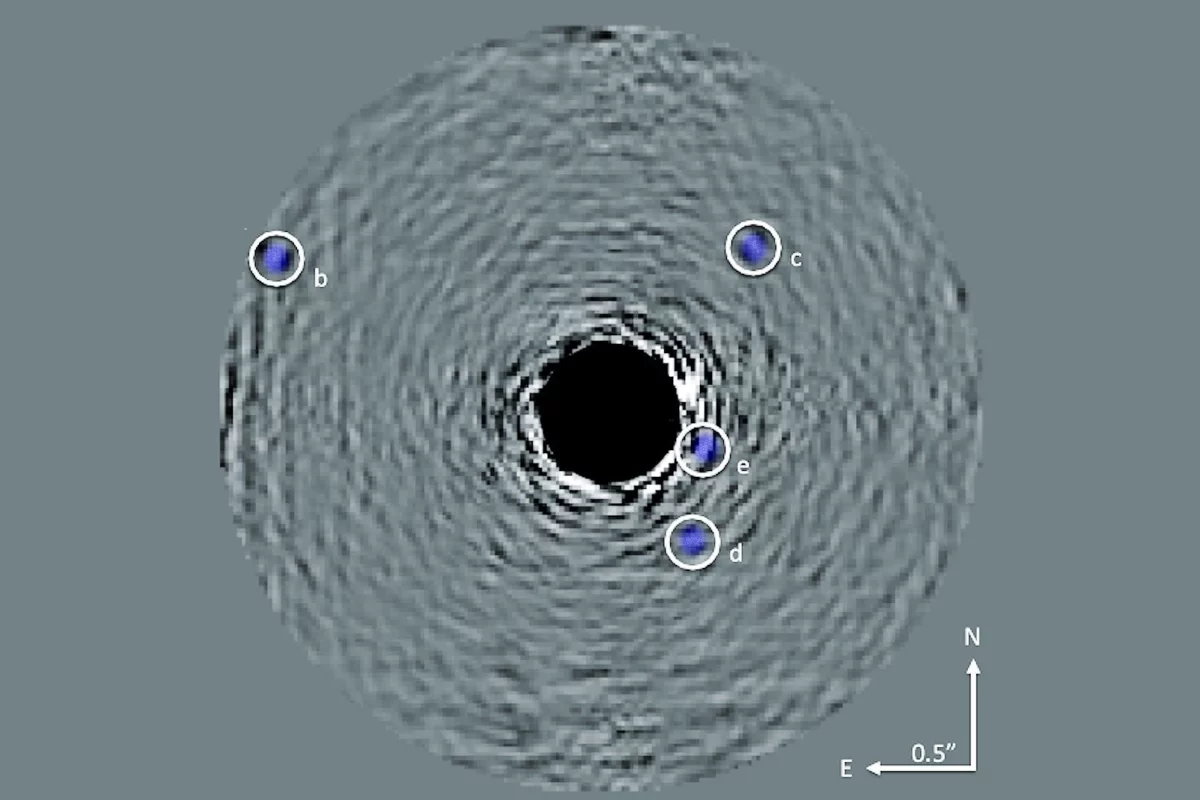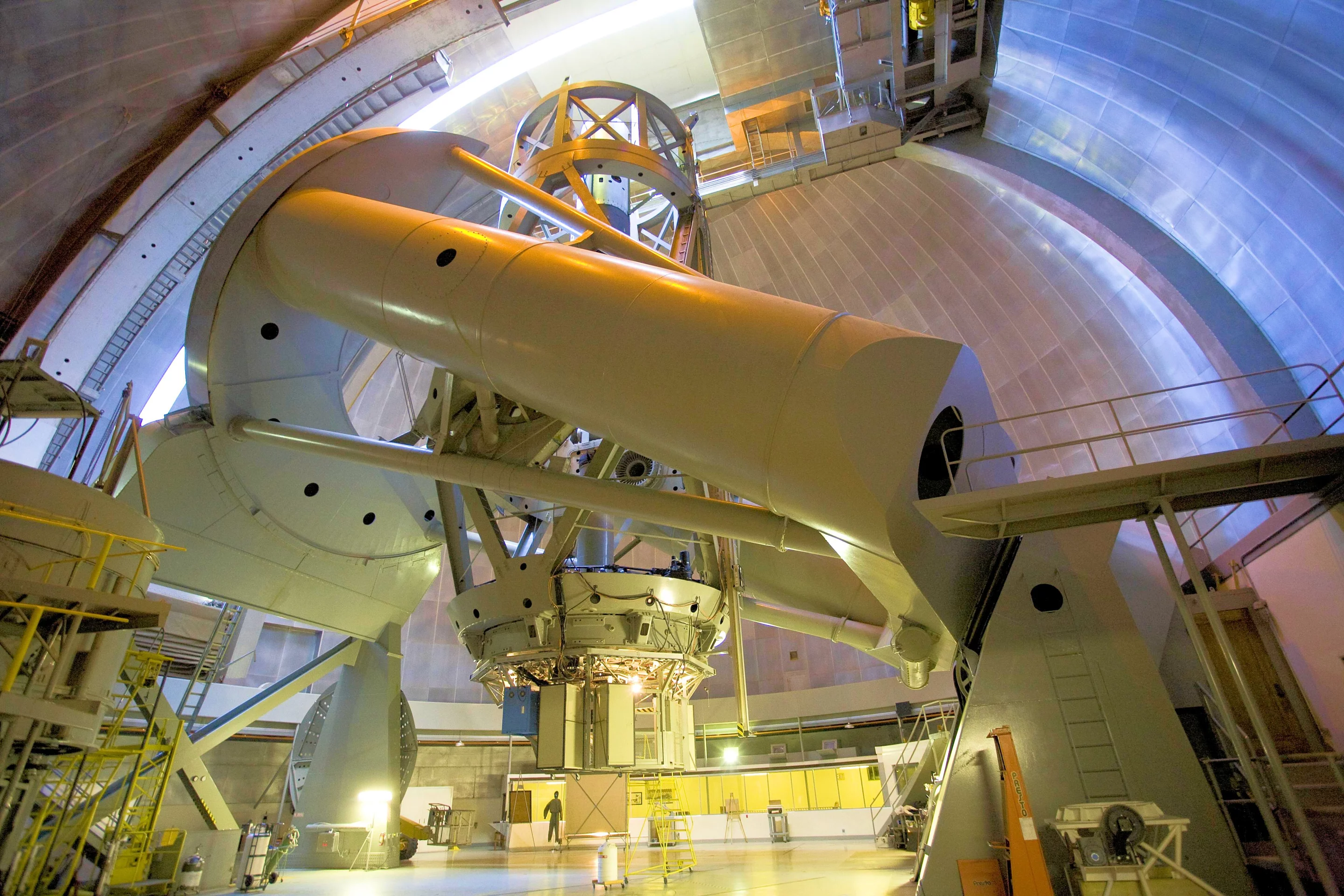While the number of exoplanets so far identified is steadily marching towards the 1000 mark, fewer than twenty have been discovered in the course of direct observation by astronomical telescopes. Four of them (HR 8977 b,c,d,and e) circle an unprepossessing A5 star called HR 8977, which lies about 130 light-years distant from Earth. Thanks to the little-known astrophysics research arm of the American Museum of Natural History (AMNH), we now have the ability to examine the makeup of their atmospheres by taking simultaneous spectrographs of all four planets.
AMNH's Project 1640 funds a three-year survey searching for exoplanets. It also funded development of the highest contrast imaging system in history. Used in combination with the Palomar five-meter Hale telescope, the main objective is to acquire and compare spectra of young, warm giant planets in an attempt to fill in the gaps in our current understanding of planetary formation.
Seeing exoplanets is difficult
To convey an idea of how difficult it is to image exoplanets with a telescope, imagine there's a planet called planet "J" that is the twin of Jupiter orbits HR 8977 at the same distance the real Jupiter orbits around the Sun. From HR 8977's distance of 130-light years, the apparent separation between HR 8977 and J would be 0.14 arcsec (seconds of arc), which could be resolved by the Hubble space telescope or ground-based scopes with adaptive optics. The real problem is that J would be enormously dimmer than HR 8977, which appears from Earth as a sixth magnitude star, barely visible to the unaided eye. J would appear at magnitude +27, about 250 million times fainter than the star. An isolated star with this brightness is just detectable in ground-based telescopes, but not when it is 0.14 arcsec distant from a second star 250 million times brighter.
Not all exoplanets are this difficult to see, however. HR 8977 b, c, d, and e orbit HR 8977 at distances ranging from three to 14 times Jupiter's orbital radius, leading to angular separations of 0.4 to 2.0 arcsec, thus giving a bit more elbowroom to try to separate the light of the planets from the light of the star.
The main factor making it possible to see the planets of HR 8977 is that they are hot – about 900-1100 K. The planets are gas giants several times more massive than Jupiter, and they are quite young – in fact, HR 8977 itself appears to be only about 30 million years old, although not all astronomers agree. The planets formed recently (in cosmic terms) by condensing from clouds of gas and dust, and are still being heated by gravitational contraction.
The internal glow driven by the temperature of the planets is three or four orders of magnitude brighter than the light reflected from HR 8977, particularly in the infrared. As a result, HR 8977 is only about 100 thousand times brighter than are its orbiting planets. This is still a large difference, but one that can be managed with suitable optical equipment.
Project 1640
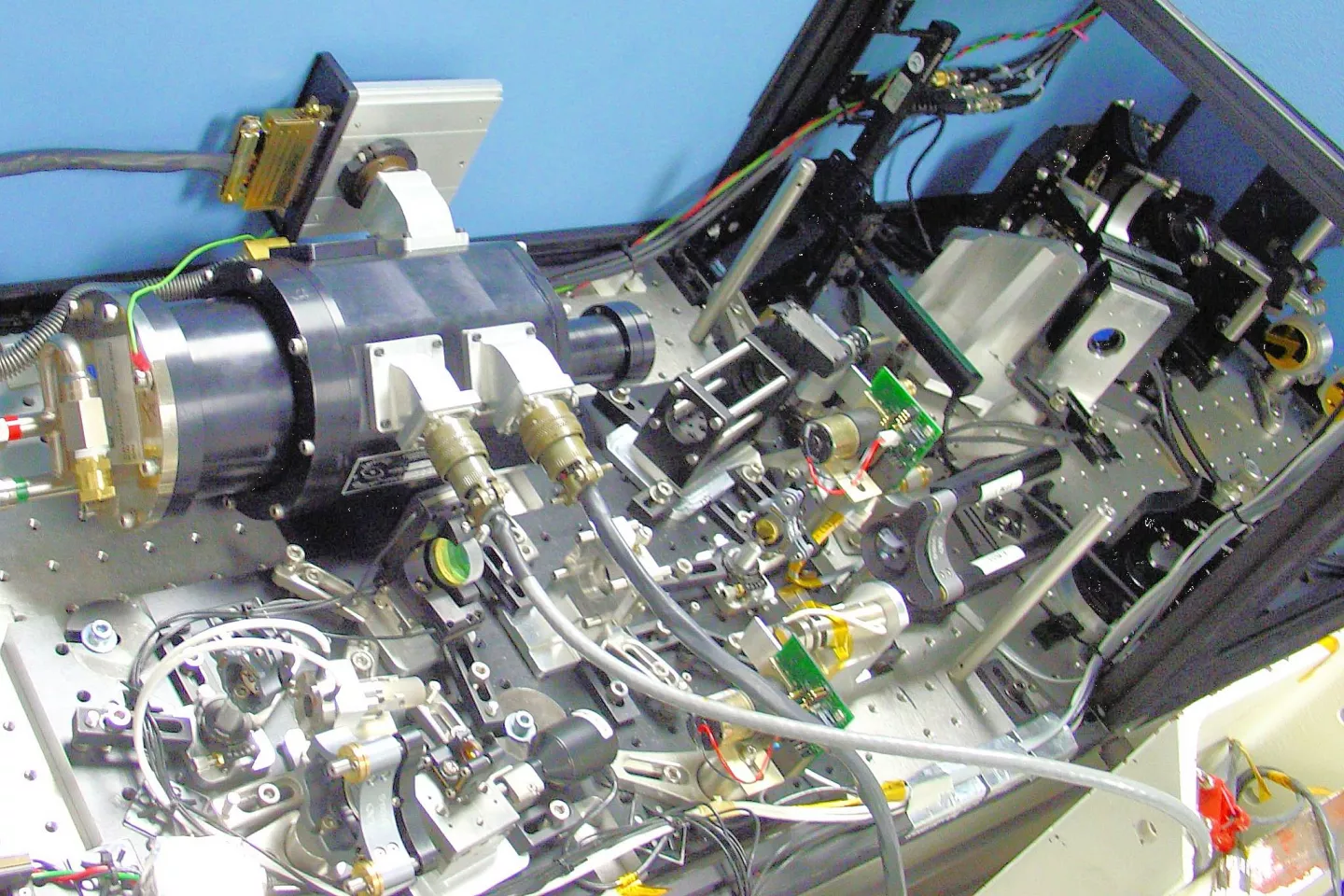
The Project 1640 instrumentation takes on this challenge by taking a state-of-the-art adaptive optics system, a coronagraph, a hyperspectral imager and a unique wavefront sensor calibration unit, then adding them to the five-meter Hale telescope. The resulting system can detect objects orbiting a star that are ten million times fainter than the star itself.
Adaptive Optics
The Hale five-meter telescope has a theoretical resolving power of about 0.04 arcseconds in the near infrared. However, the practical limit to resolution when using a ground-based telescope is the distortion of the light as it passes through the Earth's atmosphere. This is called the seeing limit, and depends on the telescope's location, altitude, and local weather. The seeing limit at a typical astronomical observatory on a typical clear night is about one arcsec, although very high altitude sites may routinely achieve seeing limits of half an arcsec. Adaptive optical systems are used to help close the gap between theoretical and practical resolution of large telescopes. These work by detecting and actively reducing the wavefront distortions driven by atmospheric turbulence.
Adaptive optics on an astronomical telescope reduce the effects of atmospheric distortion. In real time, the distortions of a wavefront from a point source (either a star or a laser-generated guide star) are measured, typically using a Shack-Hartmann wavefront sensor. The reason to use laser guide stars is that the corrected field of view produced by adaptive optics is only about a minute of arc across, and very often there will be no actual stars in that area bright enough to use to measure and correct the atmospheric distortion.
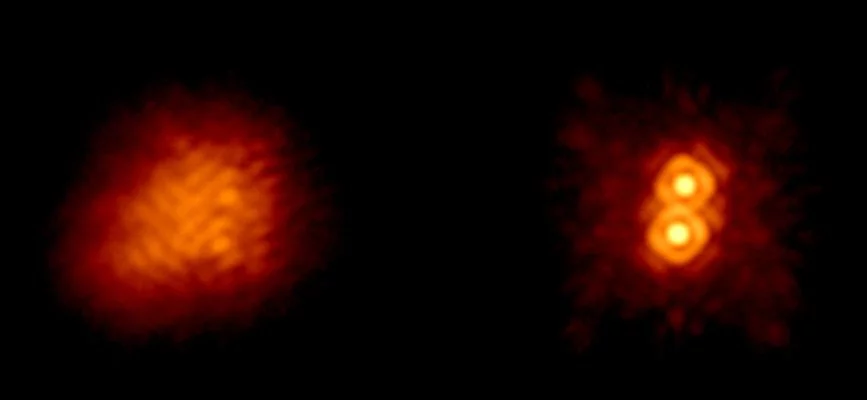
The light being imaged by the telescope reflects from a deformable mirror controlled by thousands of tiny activators. The actuators are driven by the wavefront distortions so that the wavefront of the light reflecting from the deformable mirror is flattened, a change that removes most of the effects of atmospheric distortion. The image above shows the double star IW Tauri, in which the components are separated by 0.3 arcsec, as seen by the five-meter Hale telescope. On the left is the roughly one arcsec blob seen without using the adaptive optics system, while on the right appears the image corrected with adaptive optics, showing resolution of about 0.06 arcsec. The use of an adaptive optical system clearly makes an enormous difference in the sharpness and resolution of the telescope's image.
Coronagraph
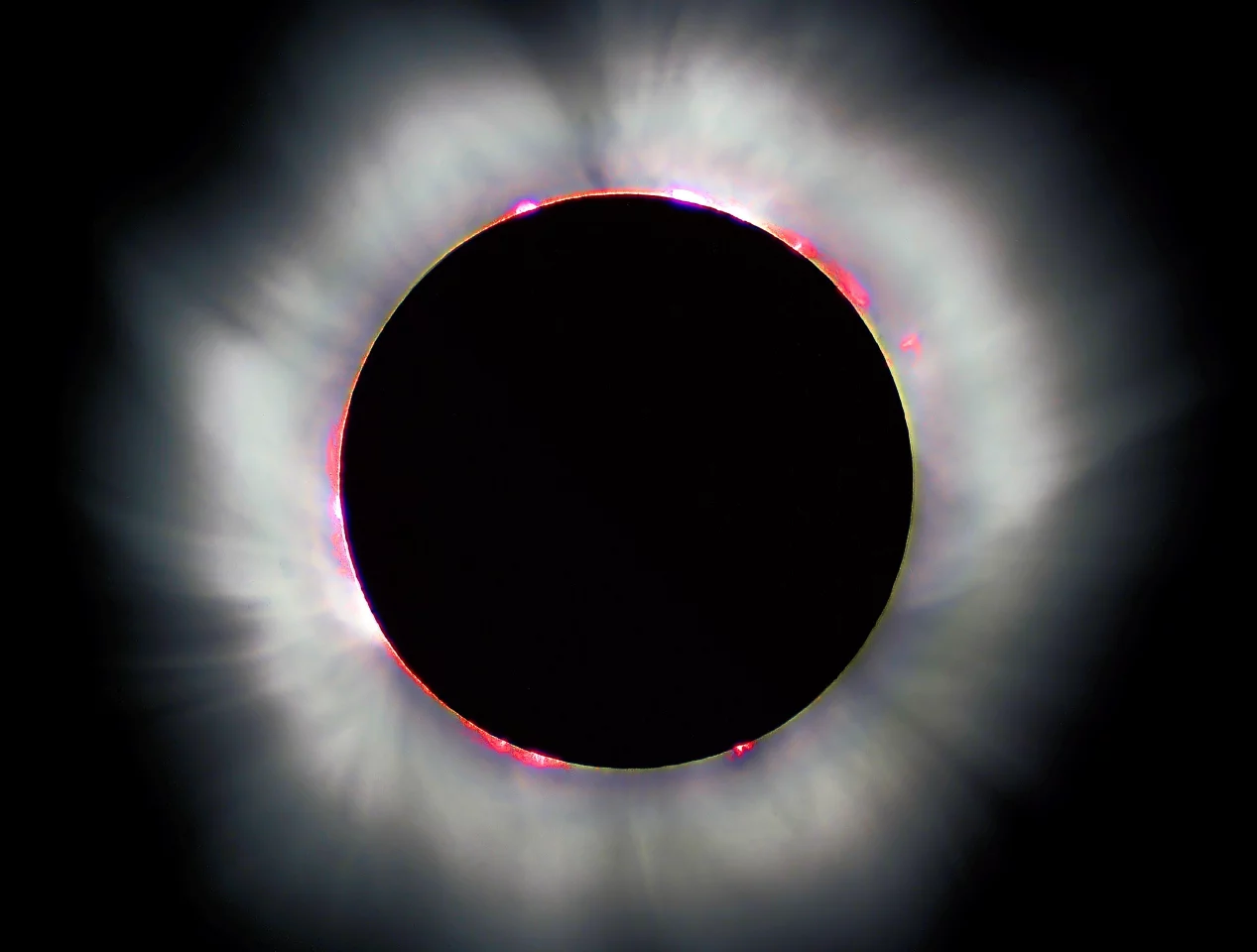
The basic principle of a coronagraph is seen during a total solar eclipse. The disk of the Sun is blocked by an object (in this case the Moon), and you can see the Sun's corona around the edge. A basic solar coronagraph for a telescope has an optical filter placed at the focal plane, so that an opaque spot on the otherwise clear filter blocks the light of the Sun. The light passing through the optical filter is then refocused, and the second image plane shows an image of the Sun's atmosphere without the Sun's disk.
The functioning of an apodized pupil Lyot coronagraph, such as used in the Project 1640 instrumentation, is basically the same, but additional efforts are made to remove scattered and diffracted light that would obscure viewing extremely dim objects in close proximity to a distant star.

The illustration above describes the essential features of a simple exoplanet coronagraph. Light from the stellar system being studied is collected by the objective lens of a telescope. Following an adaptive optical system to reduce the wavefront error of the collected light, the light is directed into the coronagraph through the field lens. The field lens brings the light to a first focus at the focal plane. Before reaching the focal plane, however, the light passes through an apodized pupil.
The apodized pupil has two main functions. First, it effectively removes the effect of diffraction from earlier hard edges by having a continuously varying optical transmisivity, rather than abrupt edges. This greatly reduces diffracted stray light. Also, the diffraction that does occur in the apodized pupil is designed to cancel out light coming in along the optical axis of the coronagraph – e.g. the central star of the stellar system.
The opaque disk at the focal plane also serves to block the light from the central star that manages to avoid destructive interference caused by the apodized pupil. The opaque disk itself causes additional diffracted stray light. However, this light is directed toward the outer edges of the second field lens, so that it is removed by the Lyot stop. Finally, the focusing lens forms an image of the stellar system on the imaging plane, in which perhaps 99.9999 percent of the incident light from the central star has been removed.
The image still contains speckles, which are an interference effect caused by residual wavefront errors. Fortunately, these are wavelength-dependent, so to distinguish a real object from the speckles, one only needs to change the wavelength of the light being studied. Any part of the image which does not move when the wavelength is changed is a real object – or at least isn't a speckle.
Hyperspectral Imager
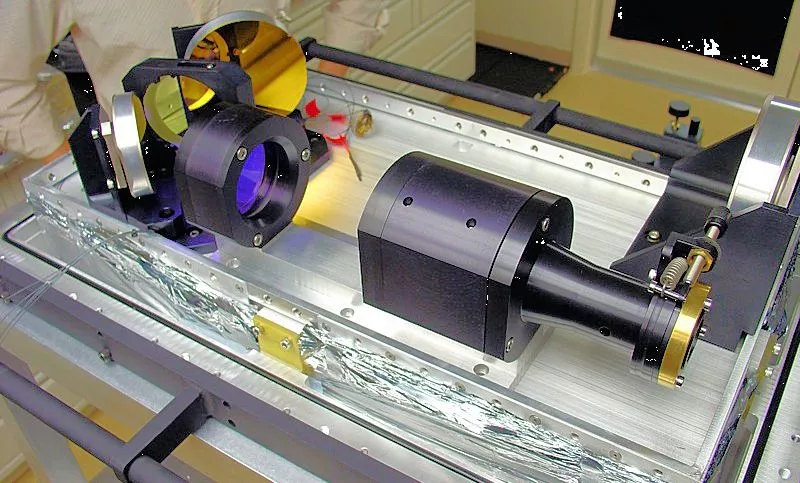
The heart of Project 1640 is the hyperspectral imager, also called the integral field spectrograph. A microlens array, comprising 40,000 individual microlenses in a 200 x 200 pattern, is positioned at the imaging plane of the coronagraph. Each microlens collects light from a portion of the coronagraph image only 0.02 arcsec across (the total field of view of the coronagraph is four arcsec across), and directs that light into a collimator.
The collimator then projects an image containing 40,000 subimages of the coronagraph pupil onto a dispersing prism, which breaks the light of the subimages into a set of 40,000 individual spectra. These spectra are then imaged by a camera onto the infrared detector, which is a 2048 x 2048 pixel HgCdTe (mercury cadmium telluride) infrared detector. The detector chip is held at liquid nitrogen temperature to reduce thermal noise.
Each of the 40,000 spectra is just over three pixels wide and 32 pixels long, and covers wavelengths of light from 0.98 to 1.75 micron. The result is that a complete set of 40,000 spatially resolved spectra is taken over the four arcsec coronagraph image simultaneously. The spectra are recorded with a low spectral resolution of only 0.025 microns per three pixel wide bin, but this is adequate to the task of examining emission and atmospheric properties of exoplanets.
HR 8977 revisited
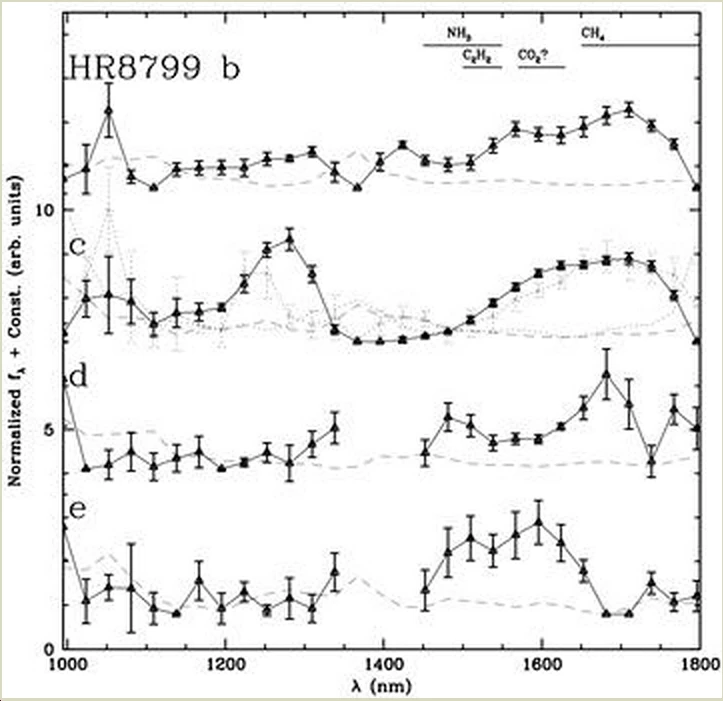
The image above shows the infrared spectra taken of HR 8977 b, c, d, and e, which orbit the star at about 68, 42, 27, and 14.5 AU (one Astronomical Unit is about 150,000,000 km), respectively. If the estimated age of 30 million years is correct, all except HR 8977b are about seven times more massive than Jupiter. (HR 8977b is about five times more massive than Jupiter.) Collection of each set of images and spectra required about 30-45 minutes of telescope time.
The importance of the age is that the mass is determined by the cooling rate of the planets – if they are older, their mass must be greater to have their current temperature of roughly 1,000 K. Note that if the age of the planets is more than about 60 million years, the "planets" would actually be brown dwarfs – substars capable of gaining some energy through fusion of deuterium in their early stages. The weight of the evidence seems to support the 30 million year age of the central star, and hence represents an upper limit for the age of the planets.
Despite the similarities of the planets, their spectra hint at rather different atmospheric chemistries. Tests show that the spectra of each of the planets are statistically distinct, meaning that they show real differences in their spectral features. The researchers make the following identification of the spectral features:
- HR 8977b – atmosphere contains ammonia and/or acetylene and CO2, but little if any methane
- HR 8977c – atmosphere contains ammonia and possibly some acetylene, but no CO2 or methane
- HR 8977d – atmosphere contains acetylene, methane, and CO2, but little or no ammonia
- HR 8977e – atmosphere contains methane and acetylene, but no CO2 or ammonia
Acetylene has never before been convincingly detected in exoplanets, but is likely to be a result of photochemistry driven by the strong ultraviolet light coming from the A5V HR 8977, which produces more than a thousand times the UV flux of the Sun. UV photochemistry is also likely to produce hydrogen cyanide, which could be confused with the CO2 emission band in the spectra. The redness of the planets also suggests the presence of considerable cloud cover.
These results are the result of a decade of development and refinement of numerous state-of-the-art methods for making extremely high contrast measurements of exoplanet spectra. Expert use of essentially all of the tools of modern astronomy – astrometry, coronagraphy, spectroscopy, photometry and various aspects of point source analysis and signal processing were focused on this extremely difficult problem.
The program is now at a new beginning – the beginning of a three-year search for exoplanets in orbit around nearby hot stars. Further improvements in the methods and implementations may result in the ability to directly image and investigate atmospheric features of exoplanets that are cooler and more closely resemble our solar system. This is a new path for exoplanet research, which should add to the general excitement of the search for Earth-like planets.
